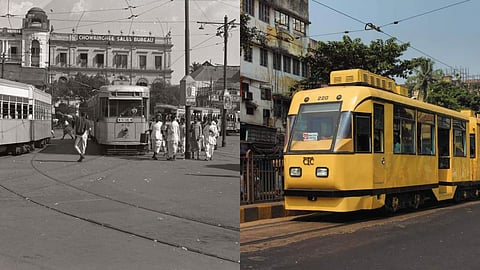
- HOMEGROWN WORLD
- #HGCREATORS
- #HGEXPLORE
- #HGVOICES
- #HGSHOP
- CAREERS
- ABOUT US
- CONTACT US

Satyajit Ray’s 1964 film ‘Mahanagar’ (The Big City) opens with a close-up shot of the sparks that fly from the cable when a tram runs. As the opening credits fade in and out of the frame and the two-minute-long title sequence ends, the camera moves inside the carriage and freeze-focuses on the tired face of Anil Chatterjee, who plays one of the film’s main characters. The tram becomes a stand-in for the big city — its endless grind and tedium. In ‘Apur Sansar’ (The World of Apu), too, Ray uses the mechanical transport as a stand-in for the big city — only this time it becomes a vessel for the protagonist’s hopes and dreams. Sitting in a tram carriage, Soumitra Chatterjee’s Apu reads the letter from the editor, and his dream becomes reality.
From films to music, Kolkata’s iconic trams have been an inseparable part of the city’s identity. Once an icon of the city’s industrial prowess, the tramways epitomised the city's rich historical heritage and past grandeur. After running for 151 years, however, the story appears to be nearing its last chapter. On Tuesday, September 24, State Transport Minister Snehasis Chakraborty announced that the West Bengal Government would be discontinuing tram services across the city, with the exception of a short heritage stretch between Maidan and Esplanade in Central Kolkata.
The first horse-drawn trams in India made their maiden journey on a short 4 kilometre stretch from Sealdah to Armenian Ghat in Kolkata on February 24, 1873. Three years after this trial run, the Calcutta Tramways Company was formed and registered in London in 1880 and metre-gauge tram tracks were laid from Sealdah to Armenian Ghat via Bowbazar Street, Dalhousie Square, and Strand Road. The route was inaugurated by then Viceroy of India, Lord Ripon, on November 1, 1880.
Originally used to haul goods from river ports and railway stations, the service was soon expanded to accommodate people. In 1882, the first steam locomotive-drawn trams were launched in India; and the first electric tramcar in Asia ran from Esplanade to Kidderpore on March 27, 1902. By the turn of the century, the tramways had become such a popular mode of public transport that the Calcutta Tramways Company owned 166 tramcars, a thousand horses, seven steam engines, and 19 miles of track. At its peak, the CTC provided tram services on 37 routes across the city.
Since the 1970s onwards, however, Kolkata’s tramways experienced a steady decline in popularity. With more cars and buses on Kolkata’s narrow streets, trams became a cumbersome mode of transport and added to the city’s persistent problem of traffic congestion. Still, trams remained popular among many Kolkatans. As their use as an economical mode of public transport dwindled among Kolkata’s office workers, the trams became refuges for the city’s college students who found privacy in the mostly empty, cosy carriages during noon.
Until very recently, tram rides were some of the most affordable and romantic dates you could take your partner to in Kolkata, with ticket prices starting at only 10 rupees per person. Naturally, Kolkata’s trams inspired many Bengali songs like Shreya Ghoshal’s ‘Chawl Rastaye’ — one of my favourite Bengali love songs.
The slow death and the now seemingly near-certain discontinuation of Kolkata’s trams truly signify the end of an era. At a time when the world is experiencing unprecedented climate change leading to some of the worst heat waves in recorded history, our governments should be focusing on more sustainable, eco-friendly public transport systems like electric trams which run on over 450 cities globally. Instead, our leaders appear to be hell-bent on making things worse. With the final bell on Kolkata’s trams tolling in the distance, the City of Joy doesn’t feel so joyful today.
If you enjoyed reading this, here's more from Homegrown:
Artist Sayan Mukherjee Has Transformed A Kolkata Tram Into A Moving Canvas For Durga Puja
Travel Back To The 70s With This Kolkata Tram Converted Into Restaurant
Patal Rail: How Kolkata's Underground Metro Is Intersecting History With Cultural Design
